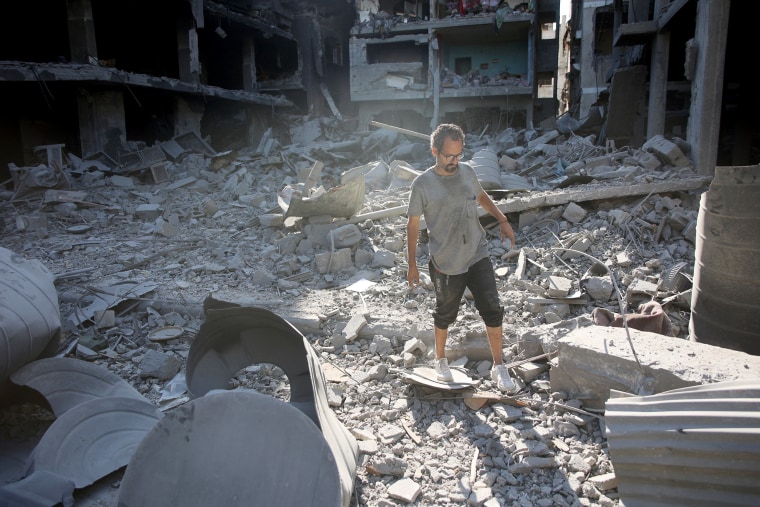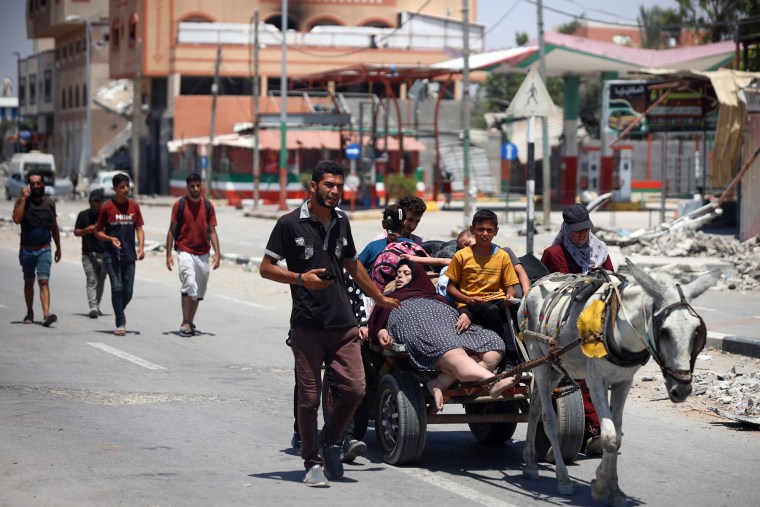The Israeli military ordered Palestinians to evacuate Gaza City and head south as it expanded operations in the north of the enclave, an area it previously said it had cleared of Hamas fighters.
As Brett McGurk, White House coordinator for the Middle East and North Africa, discussed negotiations for a Gaza cease-fire with Israeli Prime Minister Benjamin Netanyahu and Defense Minister Yoav Gallant on Wednesday, leaflets rained down on the city that was home to more than 500,000 people before the conflict, ordering those who remain to follow evacuation routes south.
The leaflets, documented by an NBC News crew in the Gaza Strip, said Gaza City would “remain a dangerous combat zone.” Civilians would be able to pass through secure corridors “without inspection” to the cities of Deir Al-Balah and Al-Zawayda in central Gaza, they said.

Calling the leaflets “psychological pressure and terrorism,” the Hamas-run Ministry of Interior and National Security in Gaza urged people against “responding” to them and it was not immediately clear as of early Thursday how many people had heeded the warning to move out of the area.
Medecins Sans Frontieres (Doctors Without Borders) said in a post on X on Wednesday that evacuation orders had forced it to temporarily close its last facility in northern Gaza.
“Our teams continued to provide care to patients until the last minute, before fleeing the area that came under heavy fire,” the aid group said. The area's sick and injured have “almost no options left for essential healthcare,” it said, adding that its team was prepared to return to the area once it was guaranteed protection.

After the IDF withdrew from Gaza's City's eastern Shejaiya neighborhood, some were counting the cost of days of heavy fighting.
“It is completely uninhabitable, even for mice or mustelids, not to mention humans,” Khadija Harara, 70, told an NBC News crew amid the rubble of what was her home. “Everything is destroyed.”
The IDF said it had dismantled eight “terror tunnels” during the roughly two-week mission in Shejaiya area engaged in “close-quarters combat.”
The IDF’s operations in northern Gaza have seen troops return to areas it previously said it had cleared of Hamas fighters.
It said Thursday that its troops were also operating in central and southern Gaza, including in Rafah, the embattled city in southern Gaza that Israel had previously declared a safe zone.
“Unfortunately, this is the very troubling situation that any place we are leaving, after occupying and clearing it, Hamas goes back,” Kobi Michael, a senior researcher at the Tel Aviv-based Institute for National Security Studies, said in a phone interview Thursday.
But, Michael, who is also a member of the Misgav Institute for National Security & Zionist Strategy, said he believed that while it was unlikely the Israeli military would be able to entirely eliminate Hamas’ presence in the enclave, it was possible to end the militant group’s control over Gaza.
The U.S. has warned that Israel is unlikely to succeed in fully eliminating the militant group’s presence in Gaza, and, together with negotiators from Qatar and Egypt, it has been pushing for a truce in the enclave.
Michael said he believed Israel’s intensified operations in Gaza are likely to be at least in part driven by a bid to put pressure on Hamas amid negotiations for a cease-fire deal.
Elsewhere, National Security Council spokesman John Kirby told CNN on Wednesday that the U.S. was "cautiously optimistic" that talks were moving in the right direction. He said gaps still remained between the two sides, but that Washington believes they can be narrowed.
During his meeting Wednesday with McGurk, Netanyahu expressed his commitment to the deal “as long as Israel’s red lines are preserved,” the prime minister's office said in a statement.
